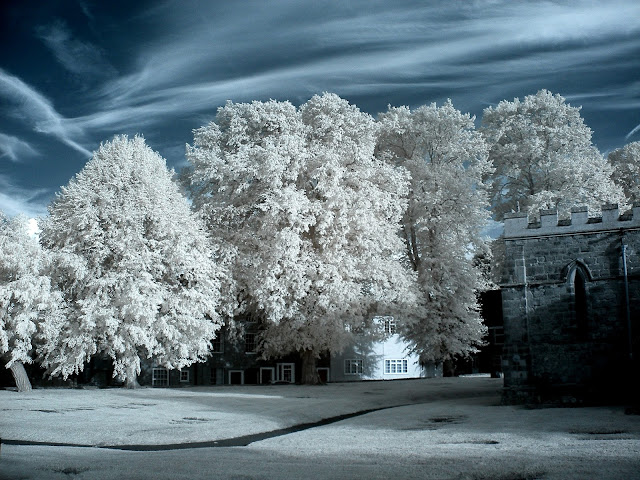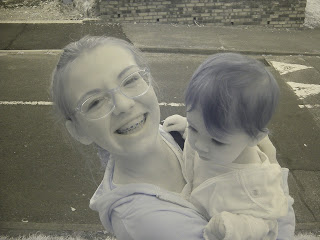A few months ago I chronicled my conversion of an old bridge camera that I had lying around into a infra-red play thing.
Since then it has been a trusty companion over the last few months and I thought it would be a good time to document what I have learned in using it.
The first thing to state, is despite is lowly specifications (7MP) I can truly say that I have had more fun with with this little hacked cameras than with my more expensive and larger DSLR kit over the summer months.
There are a number of reasons for this,including it's novelty and learning about new photography techniques, but a large part is down to the cameras lightness.
Despite my main camera being a comparativelysmall DSLR. I have come to appreciate a camera that does not weigh you down. In fact, so much so, that I have started to re-think my next camera choices.
I had been tempted bya Sony A-77 Mk II (on the basis that it now seems likely that their will never be another A -Series DSLR). However while now doubts a fine camera, it is comparison with my present kit, a heavy and large beast. So now I ma considering a Sony A-6000 (presuming there is no new consumer E-Format camera in the next few months ). I have even begin to think the unthinkable about other small mirror less cameras such as the Olympus OM-D E-M10 or the Fujifilm X-T10.
However that is all for the future. What I want to say now is what I found after playing around with IR photography for a few months.
The Best Subjects
Like I said, I have been taking a lot of IR photos over the last few months and I feel I am starting to get an idea about the best ways to take IR photos.
So what have I found in the last few months.
The Good
Trees.
Trees just look fantastic in IR, particularly when in full foliage. In fact I am in danger of starting to build a collection consisting of just standalone trees. Now I cannot resist taking pictures of lone trees against a sky background in IR.
They look especially good with a 850mm filter on. This is because foliage is such a great IR reflector that you get great definition without the green from the leaves overwhelming the picture (eyes are very sensitive to green so can obscure other details)
Clouds
One of the great advantages of IR photography is that IR light is not absorbed by water vapour as much as visible wavelengths are.
This means otherwise hazy skies have much greater contrast and definition in IR light. Take an IR picture on what otherwise appears to be an overcast day, and it results (to my eyes anyway) in pictures of stunning skies, with great cloud definition. I find IR works particularly well when the sky is partially cloudy, but not great on totally overcast days
Landscapes
Since IR photography takes such great pictures of trees and skies, it should be no surprise that landscapes look great too. Because grass is a great IR reflector too, landscapes get an almost fairyland appearance, like they are winter snowy scenes (but without the need to endure sub-zero temperatures to obtain them)
Buildings
Buildings, especially when in full sunlight come out with high contrast, which really suits architectural photography. I'm a great fan of Joel Tjintjelaar and Julia Anna Gospodarou work in taking high contrast black and white pictures of buildings and cities and I wonder whether there is a role of IR in this form of photography
Bare Metal
Anything with bare metal such as old cars, motorbikes and vintage aircraft all look really good in IR. (Trivia point. David Lean's much underrated film the breaking the sound barrier used IR film for many of the flying sequences).
One of my issues with the camera is that it istoo slow to capture such images apart from when they are static.
The bad.
So IR cameras can take some great images, but there are downsides
Low Light
Some think that IR photography allows you to take pictures in the dark. However this sort of camera is just not sensitive enough for that sort of photography.
In fact with the filter basically cutting out over a third of the available light, it is actually far less sensitive than a normal camera before the conversion.
The camera I converted is a product of its age and was not greatly sensitive to begin with. In fact one of the things that has improved greatly with modern cameras is how far you can push their sensitivity before noise starts becoming a problem. However with this camera, anything oner ISO 200 risks too much noise. So generally the camera only works well with a wide aperture in good light
Noise
The corollary of low light performance is image noise. In truth all IR photography will suffer from noise due to the fact we are using just one channel of our sensor(link?). This means the sky especially can show a lot of salt and pepper noise. Now this can be removed with a good photo package, but with the risk of a subsequent loss in sharpness. Saying that, some people actually like the noise and it can add to a picture in some situations.
Photos into the sun.
With IR you have to be very careful in where you are in relation to the sun.
Generally any picture taken up to 45 degrees from the sun will result in flares in the photo. Again these can sometimes add to a picture, but it is a hit and miss affair and generally should be avoided. One thing I need to try, is to see if fitting a sun hood will help in this.
However generally it is a good idea to try and take the pictures with the sun behind you as much as possible.
 |
| Like Icarus, too close to the sun. Not ruined though |
The Ugly
People.Not all subjects come out well in IR photography.
While people give off IR, the camera is just not sensitive enough to distinguish features well. People come out bland, washed out and pretty weird in IR, so IR portraits are probably not a good idea.
However that doesn't mean you should never take photos of people, but you need to be aware of it's limitations (It have some interesting ideas how I can use the effect as we move into Halloween)
Other thoughts
Filters
So far I have bought only two filters to put on the front of the camera, a 720nm and 850nm filter. The difference being is that a 720nm crosses the cusp between visible and IR light, meaning as well as getting more light through, we also get some color.
The 850nm lets virtually no visible light through at all, but you do get a "purer" infra red image.
Of course there is nothing stopping you converting a photo using the 720nm into black and white later, but I must admit I like the 850nm more and have probably spent a lot more time with it.
I have found myself using the 850nm filter far more than the 720nm just because I like the effects.
Processing
The advantage of the 720nm filter is that it can be processed to give blue skies. This a bit of a trick caused by the fact that red in the sky leaks through with this filter on. To get a blue sky from the red, what is required is to swap the red and blue channels. While the effect can be effective, to me it can appear a little faked. Also it actually results vary widely and I need to experiment to see what are the best ways to achieve this effect.
With a 850nm filter, the image benefits from compressing the limits a little bit. In fact I find the most effective IR photos are those where the limits can be easily compressed without losing the signal.,
Apart from that, some noise reduction can benefit some photos, especially if the sky is very noisy.
 |
| 720nm picture before swapping the channels |
 |
| After processing |
Going forward
Like I said, I have had some great fun with the camera despite its lowly specifications. However as with all cameras, the more you use it, the more you are aware of its limitations.
Firstly, although I have not had too many problems with resolution due to the 7MP sensor , a few more MP would be useful, especially if I have to crop the image.
The biggest issue however is pour ISO noise. Because it is a camera of it's age, I don't really like pushing the ISO too much, because it quickly becomes noisy. This limits to only using the camera in good light and full aperture. It also means that the shutter speed is quite slow.
Therefore I am already thinking about doing a conversion on another Camera. While I would love to see what a Sony A7S II would do as a IR camera, I may have to set my sites a little lower. (I did see someone had done a conversion on a A7R. I have mixed emotions on this. My 1st is jealousy, my 2nd is amazement that anyone has a £1600 'spare' camera)
A tempting target is a Sony NEX-3, which are only about £100 on ebay. One downside is that it does not have a viewfinder, but in every other respect looks perfect.
Until then I still want to try some other things out, such as playing more with the 720nm filter, maybe trying some other filters and seeing what IR cameras do as we move into Autumn and Winter and seeing what happens with flashes.
Playing with IR has been a great experience to me and opened a whole new world of opportunities. You could say that I have seen my photography through a totally new light :)
Useful Links
- http://www.wrotniak.net/photo/infrared/ Bit out of date, but a good resource
- http://www.lifepixel.com/galleries/infrared-photography-gallery some quality IR photos
- Getting Started with IR - A good beginners technical guide
- IR with a A7R - Yes some people can afford to buy a A7R just for IR!
- Easy IR conversion guide
- IR Basic tutorial
- Simon Pearce IR photography
- irbuzz.blogspot.com - this blog is a bit out of date, but some useful links







No comments:
Post a Comment